Leadership Development Plan in Contemporary Organizations - Report
VerifiedAdded on 2023/06/11
|9
|2247
|51
Report
AI Summary
This report outlines a leadership development plan for an individual aiming to transition from a product engineering role to an operations position within three years. It details current and future developmental goals, personal objectives, and a defined timeframe. The plan incorporates relevant leadership theories and current industry trends, including global leadership, cognitive psychological leadership, and e-leadership. It also addresses the importance of flexibility and innovation in contemporary leadership practices. The plan includes a detailed action plan focusing on skills such as confidence building, trust, ethics, group development, innovation, and sustainable leadership, along with methods for monitoring and evaluation. This framework aims to support the individual's growth and track their progress toward achieving their leadership objectives.
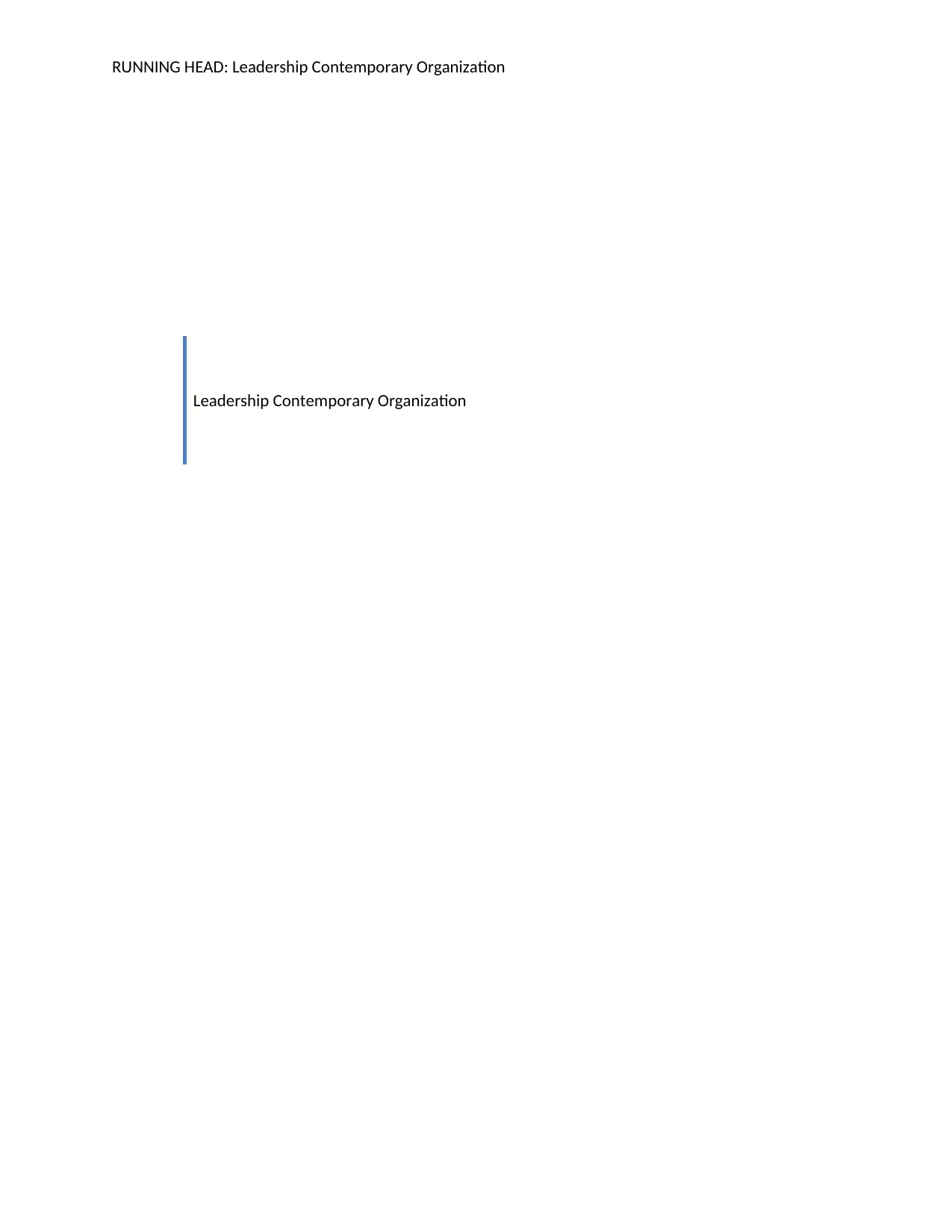
RUNNING HEAD: Leadership Contemporary Organization
Leadership Contemporary Organization
Leadership Contemporary Organization
Paraphrase This Document
Need a fresh take? Get an instant paraphrase of this document with our AI Paraphraser
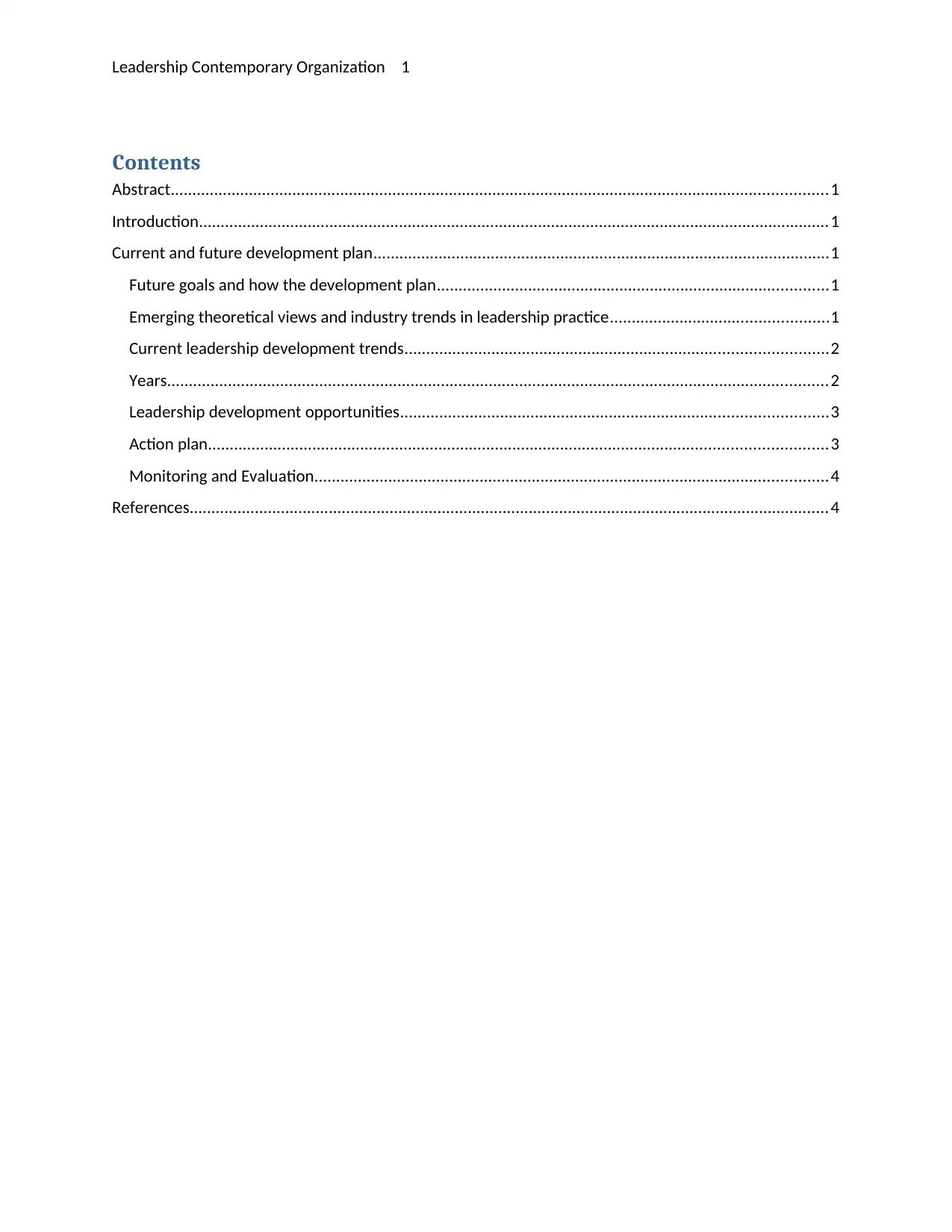
Leadership Contemporary Organization 1
Contents
Abstract.......................................................................................................................................................1
Introduction.................................................................................................................................................1
Current and future development plan.........................................................................................................1
Future goals and how the development plan..........................................................................................1
Emerging theoretical views and industry trends in leadership practice..................................................1
Current leadership development trends.................................................................................................2
Years........................................................................................................................................................2
Leadership development opportunities..................................................................................................3
Action plan..............................................................................................................................................3
Monitoring and Evaluation......................................................................................................................4
References...................................................................................................................................................4
Contents
Abstract.......................................................................................................................................................1
Introduction.................................................................................................................................................1
Current and future development plan.........................................................................................................1
Future goals and how the development plan..........................................................................................1
Emerging theoretical views and industry trends in leadership practice..................................................1
Current leadership development trends.................................................................................................2
Years........................................................................................................................................................2
Leadership development opportunities..................................................................................................3
Action plan..............................................................................................................................................3
Monitoring and Evaluation......................................................................................................................4
References...................................................................................................................................................4
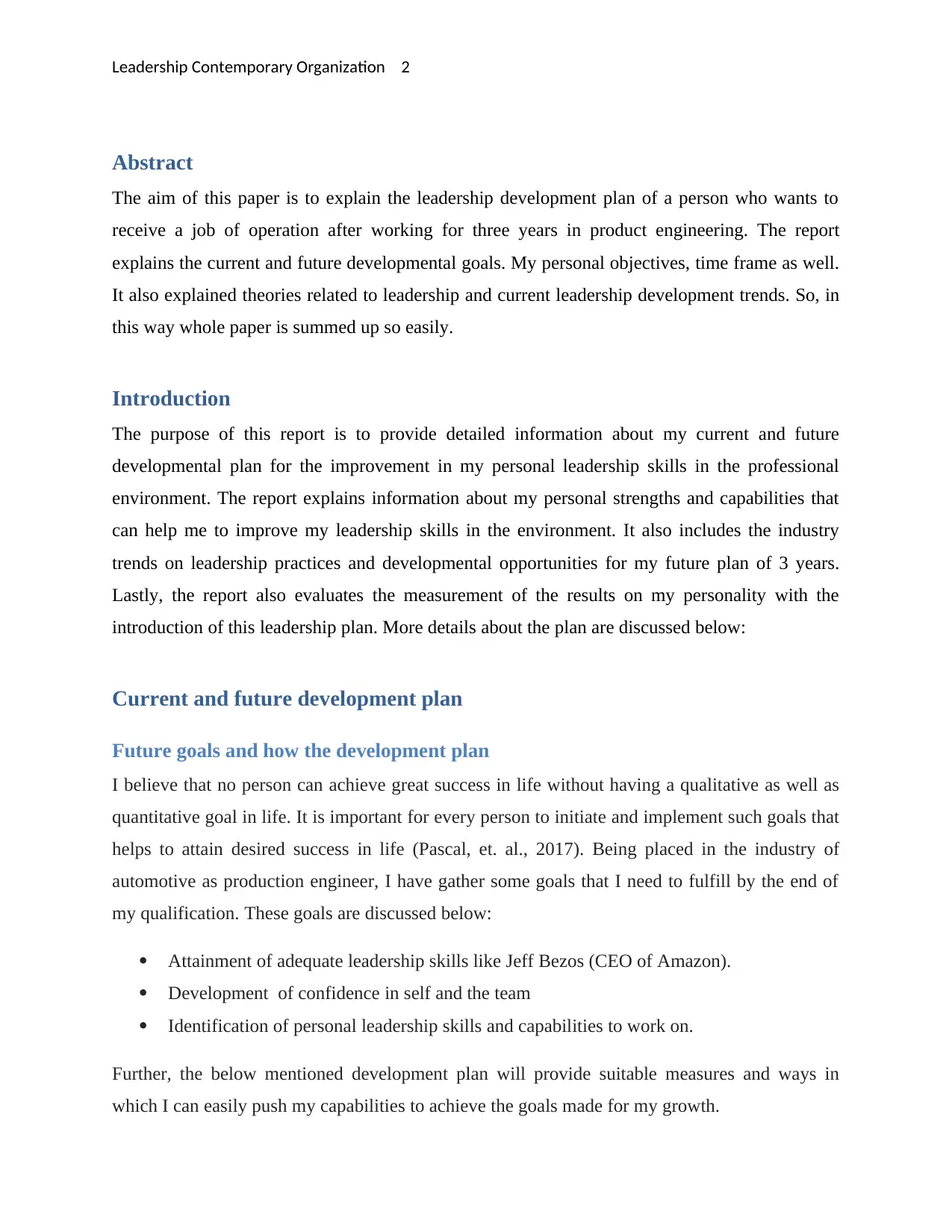
Leadership Contemporary Organization 2
Abstract
The aim of this paper is to explain the leadership development plan of a person who wants to
receive a job of operation after working for three years in product engineering. The report
explains the current and future developmental goals. My personal objectives, time frame as well.
It also explained theories related to leadership and current leadership development trends. So, in
this way whole paper is summed up so easily.
Introduction
The purpose of this report is to provide detailed information about my current and future
developmental plan for the improvement in my personal leadership skills in the professional
environment. The report explains information about my personal strengths and capabilities that
can help me to improve my leadership skills in the environment. It also includes the industry
trends on leadership practices and developmental opportunities for my future plan of 3 years.
Lastly, the report also evaluates the measurement of the results on my personality with the
introduction of this leadership plan. More details about the plan are discussed below:
Current and future development plan
Future goals and how the development plan
I believe that no person can achieve great success in life without having a qualitative as well as
quantitative goal in life. It is important for every person to initiate and implement such goals that
helps to attain desired success in life (Pascal, et. al., 2017). Being placed in the industry of
automotive as production engineer, I have gather some goals that I need to fulfill by the end of
my qualification. These goals are discussed below:
Attainment of adequate leadership skills like Jeff Bezos (CEO of Amazon).
Development of confidence in self and the team
Identification of personal leadership skills and capabilities to work on.
Further, the below mentioned development plan will provide suitable measures and ways in
which I can easily push my capabilities to achieve the goals made for my growth.
Abstract
The aim of this paper is to explain the leadership development plan of a person who wants to
receive a job of operation after working for three years in product engineering. The report
explains the current and future developmental goals. My personal objectives, time frame as well.
It also explained theories related to leadership and current leadership development trends. So, in
this way whole paper is summed up so easily.
Introduction
The purpose of this report is to provide detailed information about my current and future
developmental plan for the improvement in my personal leadership skills in the professional
environment. The report explains information about my personal strengths and capabilities that
can help me to improve my leadership skills in the environment. It also includes the industry
trends on leadership practices and developmental opportunities for my future plan of 3 years.
Lastly, the report also evaluates the measurement of the results on my personality with the
introduction of this leadership plan. More details about the plan are discussed below:
Current and future development plan
Future goals and how the development plan
I believe that no person can achieve great success in life without having a qualitative as well as
quantitative goal in life. It is important for every person to initiate and implement such goals that
helps to attain desired success in life (Pascal, et. al., 2017). Being placed in the industry of
automotive as production engineer, I have gather some goals that I need to fulfill by the end of
my qualification. These goals are discussed below:
Attainment of adequate leadership skills like Jeff Bezos (CEO of Amazon).
Development of confidence in self and the team
Identification of personal leadership skills and capabilities to work on.
Further, the below mentioned development plan will provide suitable measures and ways in
which I can easily push my capabilities to achieve the goals made for my growth.
⊘ This is a preview!⊘
Do you want full access?
Subscribe today to unlock all pages.

Trusted by 1+ million students worldwide
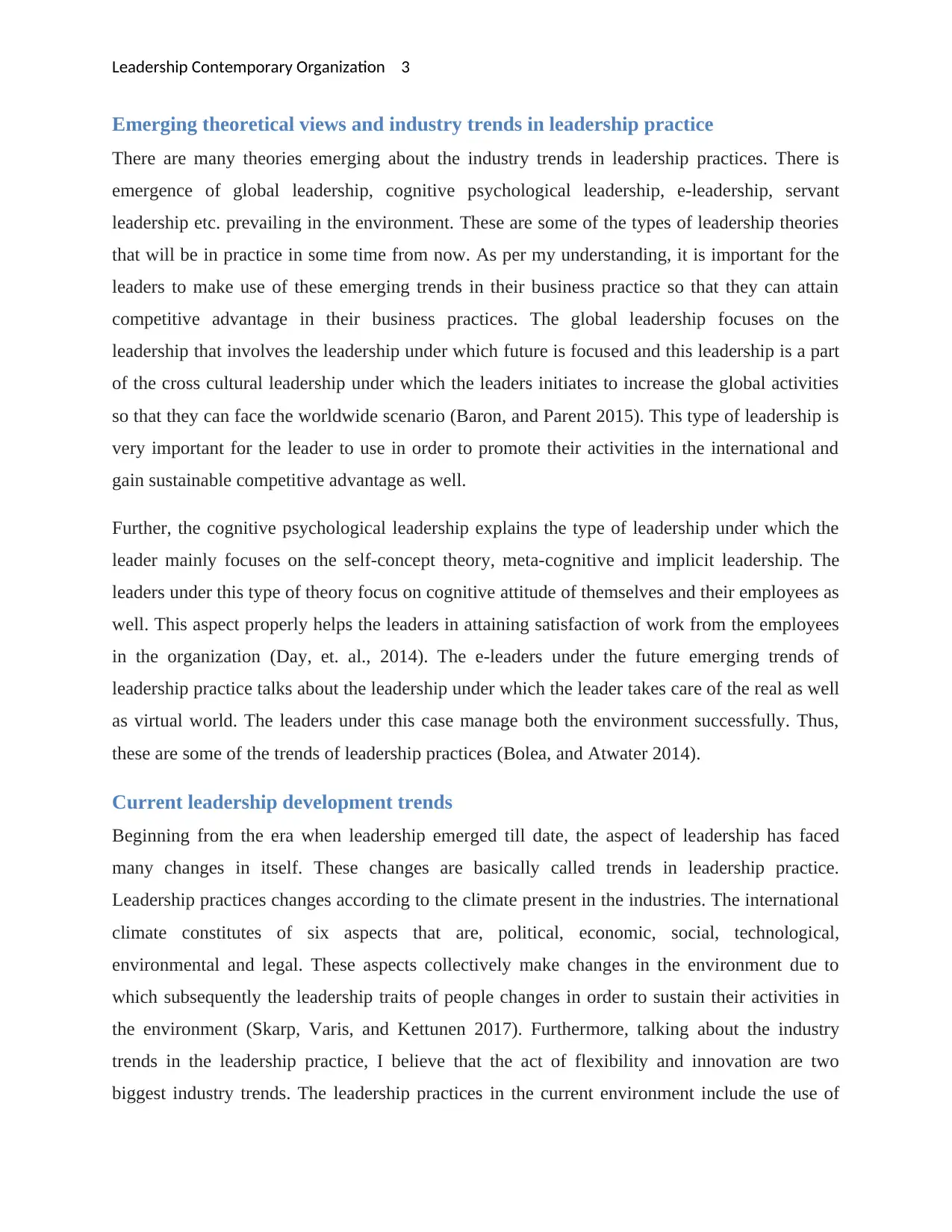
Leadership Contemporary Organization 3
Emerging theoretical views and industry trends in leadership practice
There are many theories emerging about the industry trends in leadership practices. There is
emergence of global leadership, cognitive psychological leadership, e-leadership, servant
leadership etc. prevailing in the environment. These are some of the types of leadership theories
that will be in practice in some time from now. As per my understanding, it is important for the
leaders to make use of these emerging trends in their business practice so that they can attain
competitive advantage in their business practices. The global leadership focuses on the
leadership that involves the leadership under which future is focused and this leadership is a part
of the cross cultural leadership under which the leaders initiates to increase the global activities
so that they can face the worldwide scenario (Baron, and Parent 2015). This type of leadership is
very important for the leader to use in order to promote their activities in the international and
gain sustainable competitive advantage as well.
Further, the cognitive psychological leadership explains the type of leadership under which the
leader mainly focuses on the self-concept theory, meta-cognitive and implicit leadership. The
leaders under this type of theory focus on cognitive attitude of themselves and their employees as
well. This aspect properly helps the leaders in attaining satisfaction of work from the employees
in the organization (Day, et. al., 2014). The e-leaders under the future emerging trends of
leadership practice talks about the leadership under which the leader takes care of the real as well
as virtual world. The leaders under this case manage both the environment successfully. Thus,
these are some of the trends of leadership practices (Bolea, and Atwater 2014).
Current leadership development trends
Beginning from the era when leadership emerged till date, the aspect of leadership has faced
many changes in itself. These changes are basically called trends in leadership practice.
Leadership practices changes according to the climate present in the industries. The international
climate constitutes of six aspects that are, political, economic, social, technological,
environmental and legal. These aspects collectively make changes in the environment due to
which subsequently the leadership traits of people changes in order to sustain their activities in
the environment (Skarp, Varis, and Kettunen 2017). Furthermore, talking about the industry
trends in the leadership practice, I believe that the act of flexibility and innovation are two
biggest industry trends. The leadership practices in the current environment include the use of
Emerging theoretical views and industry trends in leadership practice
There are many theories emerging about the industry trends in leadership practices. There is
emergence of global leadership, cognitive psychological leadership, e-leadership, servant
leadership etc. prevailing in the environment. These are some of the types of leadership theories
that will be in practice in some time from now. As per my understanding, it is important for the
leaders to make use of these emerging trends in their business practice so that they can attain
competitive advantage in their business practices. The global leadership focuses on the
leadership that involves the leadership under which future is focused and this leadership is a part
of the cross cultural leadership under which the leaders initiates to increase the global activities
so that they can face the worldwide scenario (Baron, and Parent 2015). This type of leadership is
very important for the leader to use in order to promote their activities in the international and
gain sustainable competitive advantage as well.
Further, the cognitive psychological leadership explains the type of leadership under which the
leader mainly focuses on the self-concept theory, meta-cognitive and implicit leadership. The
leaders under this type of theory focus on cognitive attitude of themselves and their employees as
well. This aspect properly helps the leaders in attaining satisfaction of work from the employees
in the organization (Day, et. al., 2014). The e-leaders under the future emerging trends of
leadership practice talks about the leadership under which the leader takes care of the real as well
as virtual world. The leaders under this case manage both the environment successfully. Thus,
these are some of the trends of leadership practices (Bolea, and Atwater 2014).
Current leadership development trends
Beginning from the era when leadership emerged till date, the aspect of leadership has faced
many changes in itself. These changes are basically called trends in leadership practice.
Leadership practices changes according to the climate present in the industries. The international
climate constitutes of six aspects that are, political, economic, social, technological,
environmental and legal. These aspects collectively make changes in the environment due to
which subsequently the leadership traits of people changes in order to sustain their activities in
the environment (Skarp, Varis, and Kettunen 2017). Furthermore, talking about the industry
trends in the leadership practice, I believe that the act of flexibility and innovation are two
biggest industry trends. The leadership practices in the current environment include the use of
Paraphrase This Document
Need a fresh take? Get an instant paraphrase of this document with our AI Paraphraser
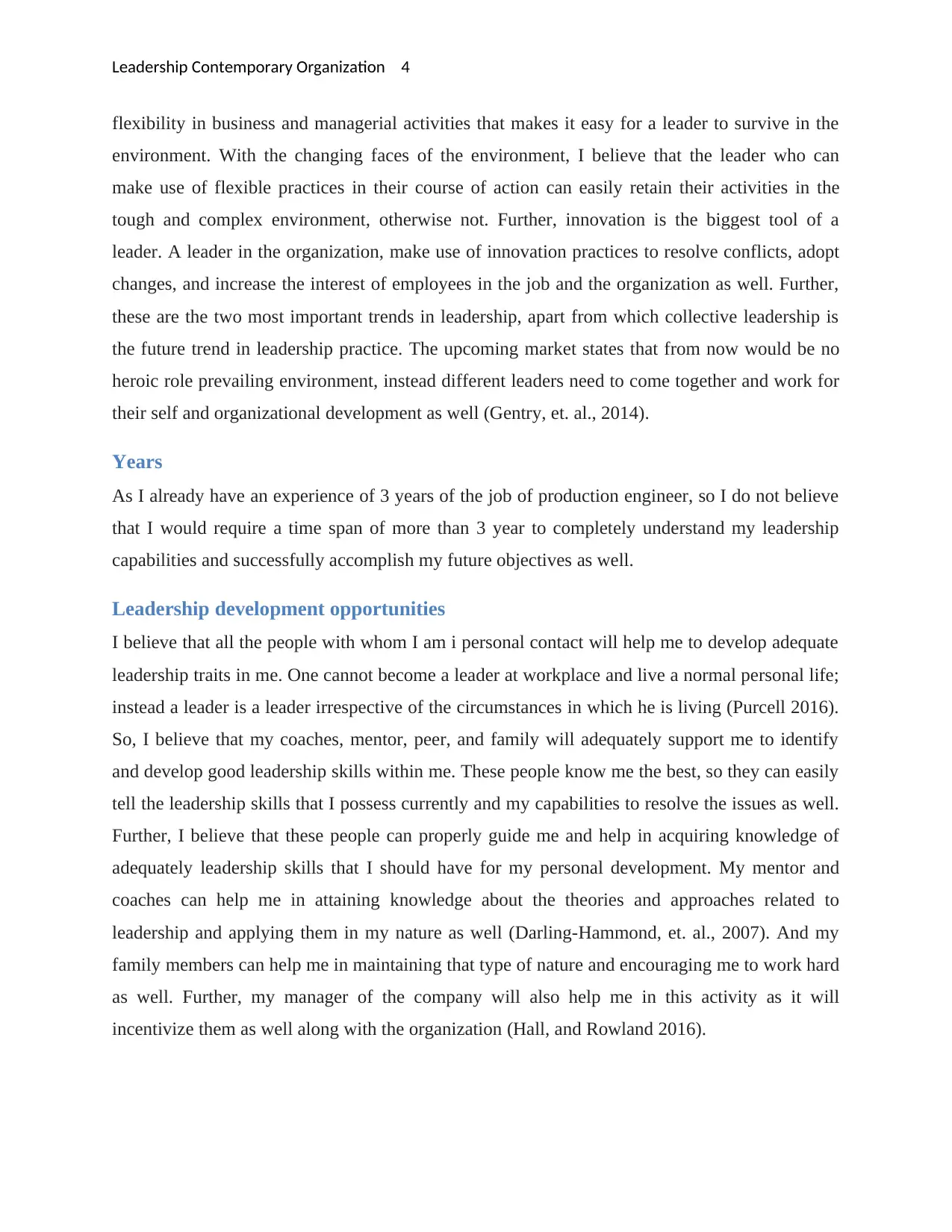
Leadership Contemporary Organization 4
flexibility in business and managerial activities that makes it easy for a leader to survive in the
environment. With the changing faces of the environment, I believe that the leader who can
make use of flexible practices in their course of action can easily retain their activities in the
tough and complex environment, otherwise not. Further, innovation is the biggest tool of a
leader. A leader in the organization, make use of innovation practices to resolve conflicts, adopt
changes, and increase the interest of employees in the job and the organization as well. Further,
these are the two most important trends in leadership, apart from which collective leadership is
the future trend in leadership practice. The upcoming market states that from now would be no
heroic role prevailing environment, instead different leaders need to come together and work for
their self and organizational development as well (Gentry, et. al., 2014).
Years
As I already have an experience of 3 years of the job of production engineer, so I do not believe
that I would require a time span of more than 3 year to completely understand my leadership
capabilities and successfully accomplish my future objectives as well.
Leadership development opportunities
I believe that all the people with whom I am i personal contact will help me to develop adequate
leadership traits in me. One cannot become a leader at workplace and live a normal personal life;
instead a leader is a leader irrespective of the circumstances in which he is living (Purcell 2016).
So, I believe that my coaches, mentor, peer, and family will adequately support me to identify
and develop good leadership skills within me. These people know me the best, so they can easily
tell the leadership skills that I possess currently and my capabilities to resolve the issues as well.
Further, I believe that these people can properly guide me and help in acquiring knowledge of
adequately leadership skills that I should have for my personal development. My mentor and
coaches can help me in attaining knowledge about the theories and approaches related to
leadership and applying them in my nature as well (Darling-Hammond, et. al., 2007). And my
family members can help me in maintaining that type of nature and encouraging me to work hard
as well. Further, my manager of the company will also help me in this activity as it will
incentivize them as well along with the organization (Hall, and Rowland 2016).
flexibility in business and managerial activities that makes it easy for a leader to survive in the
environment. With the changing faces of the environment, I believe that the leader who can
make use of flexible practices in their course of action can easily retain their activities in the
tough and complex environment, otherwise not. Further, innovation is the biggest tool of a
leader. A leader in the organization, make use of innovation practices to resolve conflicts, adopt
changes, and increase the interest of employees in the job and the organization as well. Further,
these are the two most important trends in leadership, apart from which collective leadership is
the future trend in leadership practice. The upcoming market states that from now would be no
heroic role prevailing environment, instead different leaders need to come together and work for
their self and organizational development as well (Gentry, et. al., 2014).
Years
As I already have an experience of 3 years of the job of production engineer, so I do not believe
that I would require a time span of more than 3 year to completely understand my leadership
capabilities and successfully accomplish my future objectives as well.
Leadership development opportunities
I believe that all the people with whom I am i personal contact will help me to develop adequate
leadership traits in me. One cannot become a leader at workplace and live a normal personal life;
instead a leader is a leader irrespective of the circumstances in which he is living (Purcell 2016).
So, I believe that my coaches, mentor, peer, and family will adequately support me to identify
and develop good leadership skills within me. These people know me the best, so they can easily
tell the leadership skills that I possess currently and my capabilities to resolve the issues as well.
Further, I believe that these people can properly guide me and help in acquiring knowledge of
adequately leadership skills that I should have for my personal development. My mentor and
coaches can help me in attaining knowledge about the theories and approaches related to
leadership and applying them in my nature as well (Darling-Hammond, et. al., 2007). And my
family members can help me in maintaining that type of nature and encouraging me to work hard
as well. Further, my manager of the company will also help me in this activity as it will
incentivize them as well along with the organization (Hall, and Rowland 2016).
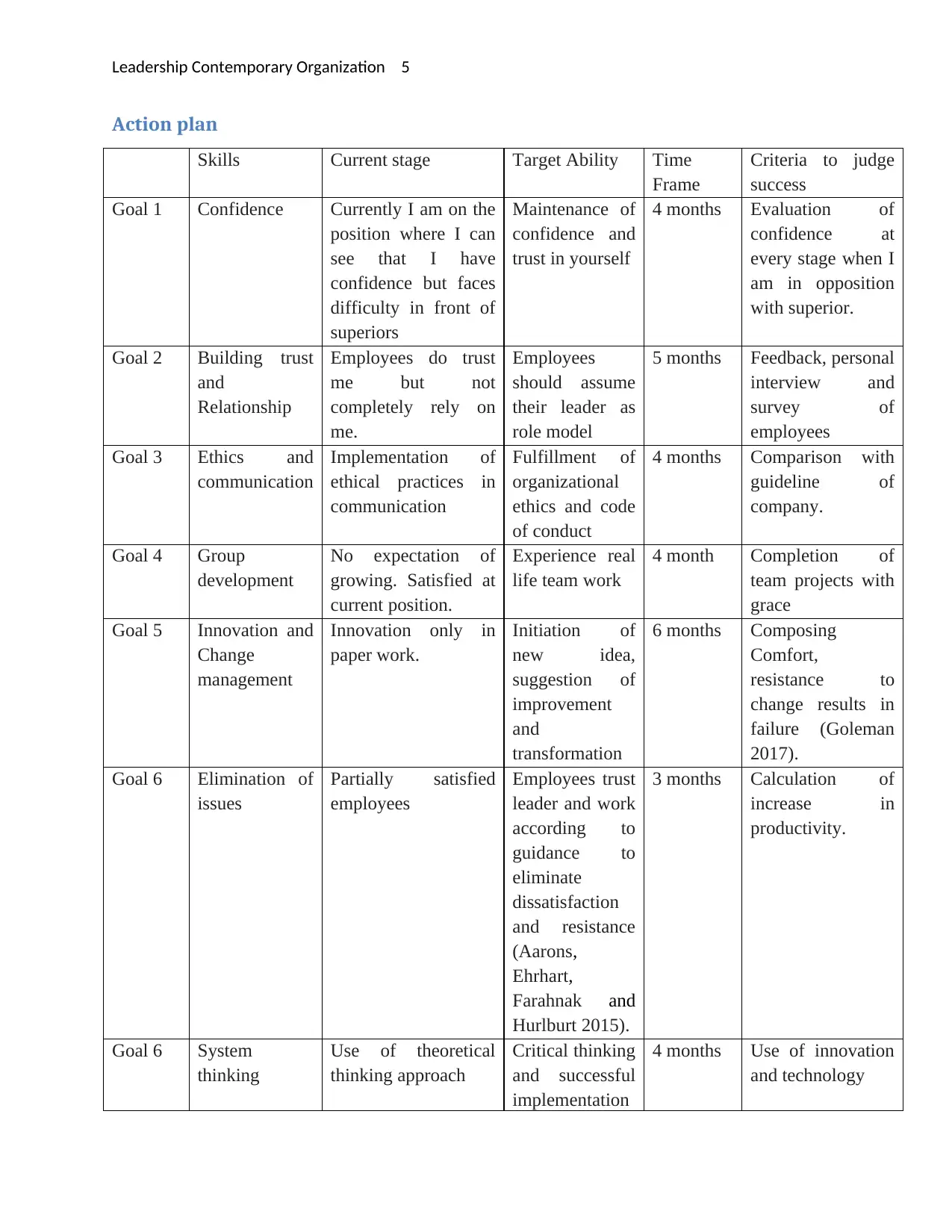
Leadership Contemporary Organization 5
Action plan
Skills Current stage Target Ability Time
Frame
Criteria to judge
success
Goal 1 Confidence Currently I am on the
position where I can
see that I have
confidence but faces
difficulty in front of
superiors
Maintenance of
confidence and
trust in yourself
4 months Evaluation of
confidence at
every stage when I
am in opposition
with superior.
Goal 2 Building trust
and
Relationship
Employees do trust
me but not
completely rely on
me.
Employees
should assume
their leader as
role model
5 months Feedback, personal
interview and
survey of
employees
Goal 3 Ethics and
communication
Implementation of
ethical practices in
communication
Fulfillment of
organizational
ethics and code
of conduct
4 months Comparison with
guideline of
company.
Goal 4 Group
development
No expectation of
growing. Satisfied at
current position.
Experience real
life team work
4 month Completion of
team projects with
grace
Goal 5 Innovation and
Change
management
Innovation only in
paper work.
Initiation of
new idea,
suggestion of
improvement
and
transformation
6 months Composing
Comfort,
resistance to
change results in
failure (Goleman
2017).
Goal 6 Elimination of
issues
Partially satisfied
employees
Employees trust
leader and work
according to
guidance to
eliminate
dissatisfaction
and resistance
(Aarons,
Ehrhart,
Farahnak and
Hurlburt 2015).
3 months Calculation of
increase in
productivity.
Goal 6 System
thinking
Use of theoretical
thinking approach
Critical thinking
and successful
implementation
4 months Use of innovation
and technology
Action plan
Skills Current stage Target Ability Time
Frame
Criteria to judge
success
Goal 1 Confidence Currently I am on the
position where I can
see that I have
confidence but faces
difficulty in front of
superiors
Maintenance of
confidence and
trust in yourself
4 months Evaluation of
confidence at
every stage when I
am in opposition
with superior.
Goal 2 Building trust
and
Relationship
Employees do trust
me but not
completely rely on
me.
Employees
should assume
their leader as
role model
5 months Feedback, personal
interview and
survey of
employees
Goal 3 Ethics and
communication
Implementation of
ethical practices in
communication
Fulfillment of
organizational
ethics and code
of conduct
4 months Comparison with
guideline of
company.
Goal 4 Group
development
No expectation of
growing. Satisfied at
current position.
Experience real
life team work
4 month Completion of
team projects with
grace
Goal 5 Innovation and
Change
management
Innovation only in
paper work.
Initiation of
new idea,
suggestion of
improvement
and
transformation
6 months Composing
Comfort,
resistance to
change results in
failure (Goleman
2017).
Goal 6 Elimination of
issues
Partially satisfied
employees
Employees trust
leader and work
according to
guidance to
eliminate
dissatisfaction
and resistance
(Aarons,
Ehrhart,
Farahnak and
Hurlburt 2015).
3 months Calculation of
increase in
productivity.
Goal 6 System
thinking
Use of theoretical
thinking approach
Critical thinking
and successful
implementation
4 months Use of innovation
and technology
⊘ This is a preview!⊘
Do you want full access?
Subscribe today to unlock all pages.

Trusted by 1+ million students worldwide
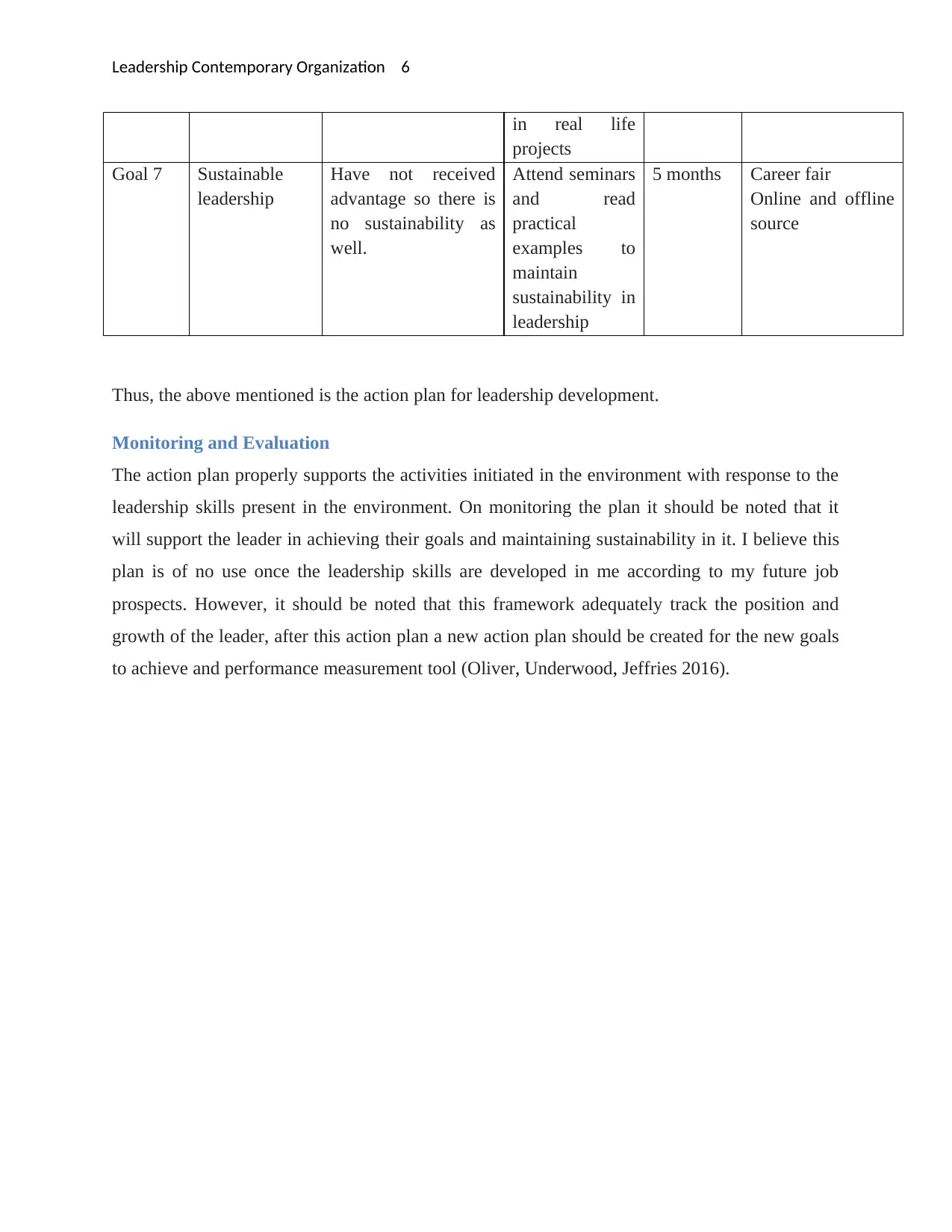
Leadership Contemporary Organization 6
in real life
projects
Goal 7 Sustainable
leadership
Have not received
advantage so there is
no sustainability as
well.
Attend seminars
and read
practical
examples to
maintain
sustainability in
leadership
5 months Career fair
Online and offline
source
Thus, the above mentioned is the action plan for leadership development.
Monitoring and Evaluation
The action plan properly supports the activities initiated in the environment with response to the
leadership skills present in the environment. On monitoring the plan it should be noted that it
will support the leader in achieving their goals and maintaining sustainability in it. I believe this
plan is of no use once the leadership skills are developed in me according to my future job
prospects. However, it should be noted that this framework adequately track the position and
growth of the leader, after this action plan a new action plan should be created for the new goals
to achieve and performance measurement tool (Oliver, Underwood, Jeffries 2016).
in real life
projects
Goal 7 Sustainable
leadership
Have not received
advantage so there is
no sustainability as
well.
Attend seminars
and read
practical
examples to
maintain
sustainability in
leadership
5 months Career fair
Online and offline
source
Thus, the above mentioned is the action plan for leadership development.
Monitoring and Evaluation
The action plan properly supports the activities initiated in the environment with response to the
leadership skills present in the environment. On monitoring the plan it should be noted that it
will support the leader in achieving their goals and maintaining sustainability in it. I believe this
plan is of no use once the leadership skills are developed in me according to my future job
prospects. However, it should be noted that this framework adequately track the position and
growth of the leader, after this action plan a new action plan should be created for the new goals
to achieve and performance measurement tool (Oliver, Underwood, Jeffries 2016).
Paraphrase This Document
Need a fresh take? Get an instant paraphrase of this document with our AI Paraphraser
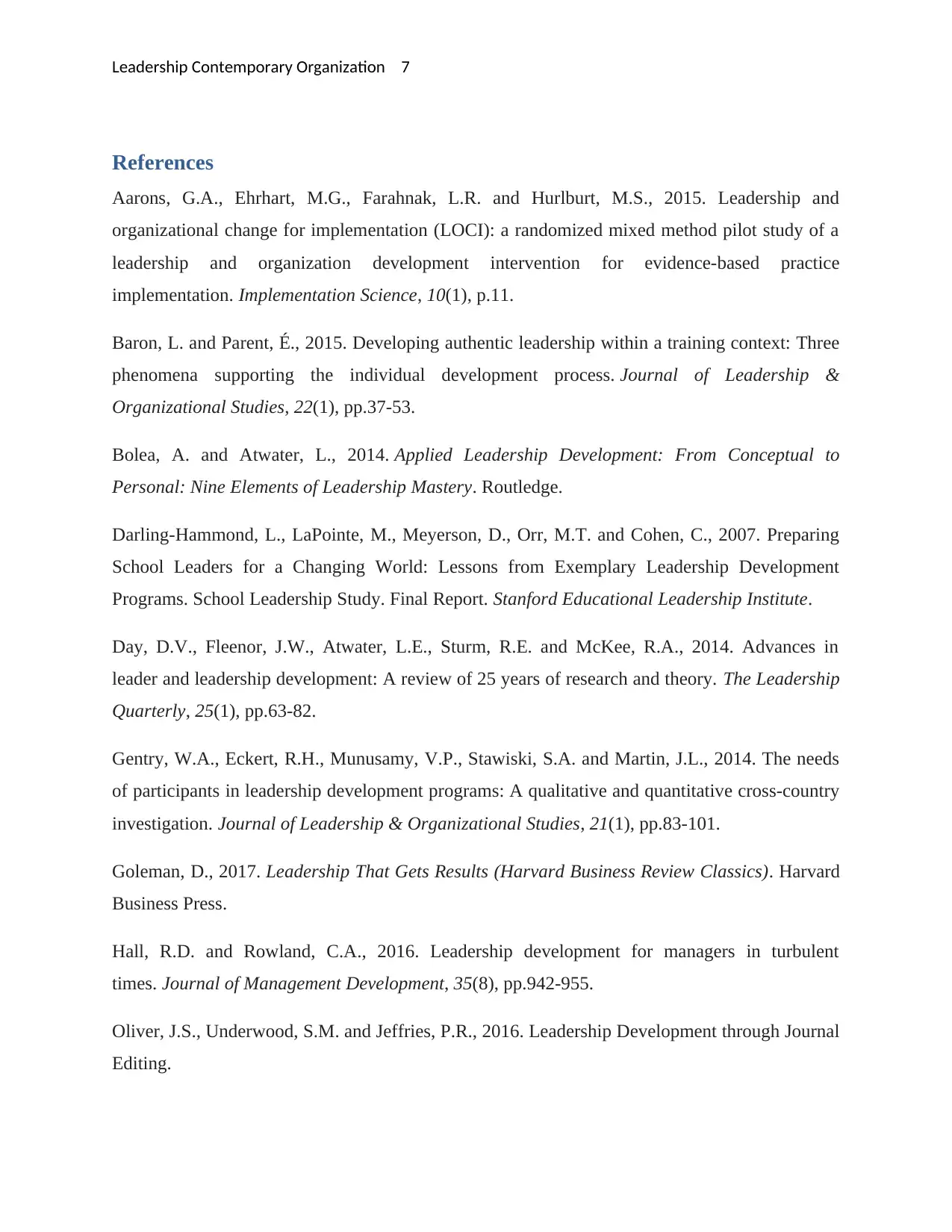
Leadership Contemporary Organization 7
References
Aarons, G.A., Ehrhart, M.G., Farahnak, L.R. and Hurlburt, M.S., 2015. Leadership and
organizational change for implementation (LOCI): a randomized mixed method pilot study of a
leadership and organization development intervention for evidence-based practice
implementation. Implementation Science, 10(1), p.11.
Baron, L. and Parent, É., 2015. Developing authentic leadership within a training context: Three
phenomena supporting the individual development process. Journal of Leadership &
Organizational Studies, 22(1), pp.37-53.
Bolea, A. and Atwater, L., 2014. Applied Leadership Development: From Conceptual to
Personal: Nine Elements of Leadership Mastery. Routledge.
Darling-Hammond, L., LaPointe, M., Meyerson, D., Orr, M.T. and Cohen, C., 2007. Preparing
School Leaders for a Changing World: Lessons from Exemplary Leadership Development
Programs. School Leadership Study. Final Report. Stanford Educational Leadership Institute.
Day, D.V., Fleenor, J.W., Atwater, L.E., Sturm, R.E. and McKee, R.A., 2014. Advances in
leader and leadership development: A review of 25 years of research and theory. The Leadership
Quarterly, 25(1), pp.63-82.
Gentry, W.A., Eckert, R.H., Munusamy, V.P., Stawiski, S.A. and Martin, J.L., 2014. The needs
of participants in leadership development programs: A qualitative and quantitative cross-country
investigation. Journal of Leadership & Organizational Studies, 21(1), pp.83-101.
Goleman, D., 2017. Leadership That Gets Results (Harvard Business Review Classics). Harvard
Business Press.
Hall, R.D. and Rowland, C.A., 2016. Leadership development for managers in turbulent
times. Journal of Management Development, 35(8), pp.942-955.
Oliver, J.S., Underwood, S.M. and Jeffries, P.R., 2016. Leadership Development through Journal
Editing.
References
Aarons, G.A., Ehrhart, M.G., Farahnak, L.R. and Hurlburt, M.S., 2015. Leadership and
organizational change for implementation (LOCI): a randomized mixed method pilot study of a
leadership and organization development intervention for evidence-based practice
implementation. Implementation Science, 10(1), p.11.
Baron, L. and Parent, É., 2015. Developing authentic leadership within a training context: Three
phenomena supporting the individual development process. Journal of Leadership &
Organizational Studies, 22(1), pp.37-53.
Bolea, A. and Atwater, L., 2014. Applied Leadership Development: From Conceptual to
Personal: Nine Elements of Leadership Mastery. Routledge.
Darling-Hammond, L., LaPointe, M., Meyerson, D., Orr, M.T. and Cohen, C., 2007. Preparing
School Leaders for a Changing World: Lessons from Exemplary Leadership Development
Programs. School Leadership Study. Final Report. Stanford Educational Leadership Institute.
Day, D.V., Fleenor, J.W., Atwater, L.E., Sturm, R.E. and McKee, R.A., 2014. Advances in
leader and leadership development: A review of 25 years of research and theory. The Leadership
Quarterly, 25(1), pp.63-82.
Gentry, W.A., Eckert, R.H., Munusamy, V.P., Stawiski, S.A. and Martin, J.L., 2014. The needs
of participants in leadership development programs: A qualitative and quantitative cross-country
investigation. Journal of Leadership & Organizational Studies, 21(1), pp.83-101.
Goleman, D., 2017. Leadership That Gets Results (Harvard Business Review Classics). Harvard
Business Press.
Hall, R.D. and Rowland, C.A., 2016. Leadership development for managers in turbulent
times. Journal of Management Development, 35(8), pp.942-955.
Oliver, J.S., Underwood, S.M. and Jeffries, P.R., 2016. Leadership Development through Journal
Editing.
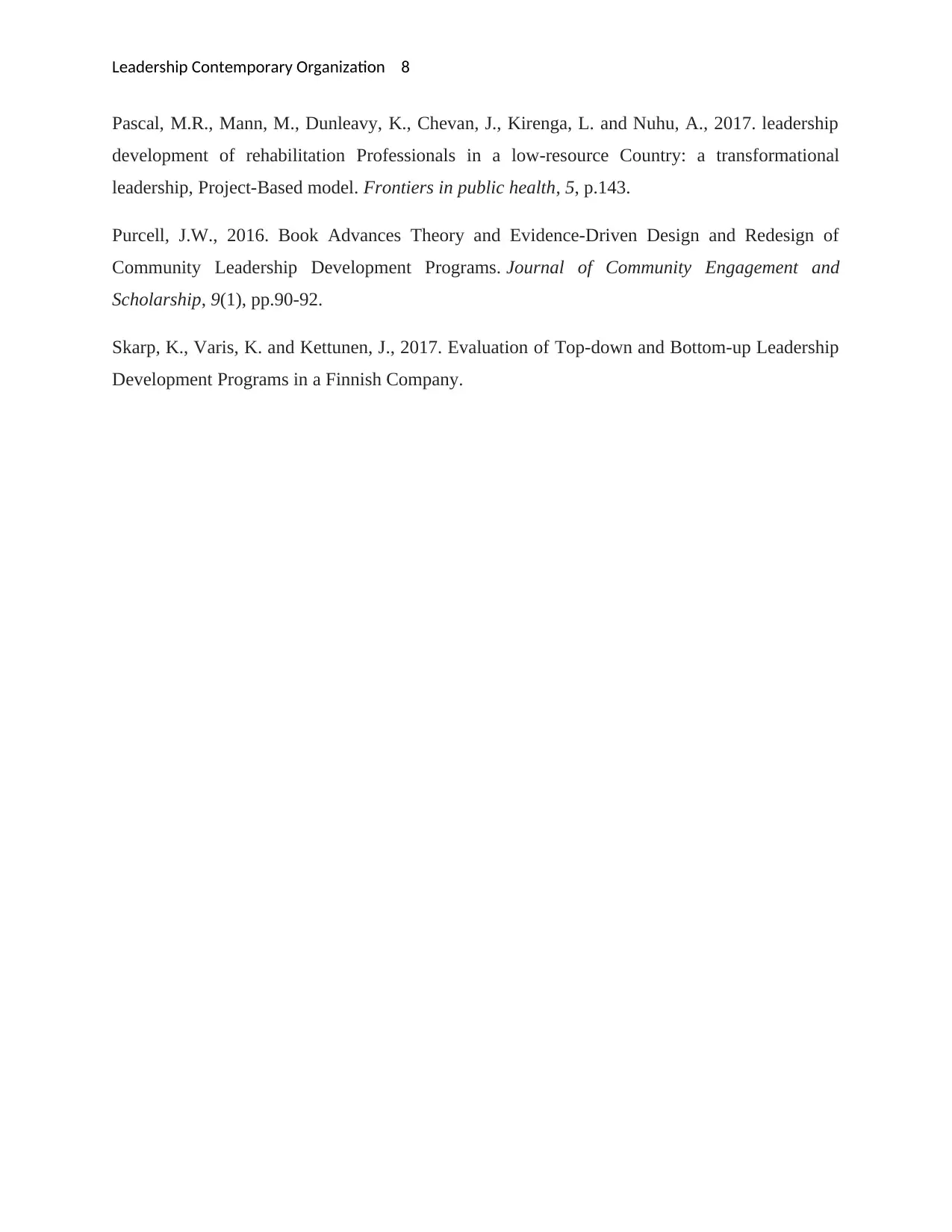
Leadership Contemporary Organization 8
Pascal, M.R., Mann, M., Dunleavy, K., Chevan, J., Kirenga, L. and Nuhu, A., 2017. leadership
development of rehabilitation Professionals in a low-resource Country: a transformational
leadership, Project-Based model. Frontiers in public health, 5, p.143.
Purcell, J.W., 2016. Book Advances Theory and Evidence-Driven Design and Redesign of
Community Leadership Development Programs. Journal of Community Engagement and
Scholarship, 9(1), pp.90-92.
Skarp, K., Varis, K. and Kettunen, J., 2017. Evaluation of Top-down and Bottom-up Leadership
Development Programs in a Finnish Company.
Pascal, M.R., Mann, M., Dunleavy, K., Chevan, J., Kirenga, L. and Nuhu, A., 2017. leadership
development of rehabilitation Professionals in a low-resource Country: a transformational
leadership, Project-Based model. Frontiers in public health, 5, p.143.
Purcell, J.W., 2016. Book Advances Theory and Evidence-Driven Design and Redesign of
Community Leadership Development Programs. Journal of Community Engagement and
Scholarship, 9(1), pp.90-92.
Skarp, K., Varis, K. and Kettunen, J., 2017. Evaluation of Top-down and Bottom-up Leadership
Development Programs in a Finnish Company.
⊘ This is a preview!⊘
Do you want full access?
Subscribe today to unlock all pages.

Trusted by 1+ million students worldwide
1 out of 9
Related Documents
Your All-in-One AI-Powered Toolkit for Academic Success.
+13062052269
info@desklib.com
Available 24*7 on WhatsApp / Email
![[object Object]](/_next/static/media/star-bottom.7253800d.svg)
Unlock your academic potential
Copyright © 2020–2025 A2Z Services. All Rights Reserved. Developed and managed by ZUCOL.

![University Leadership Development Plan Report - [Course Code]](/_next/image/?url=https%3A%2F%2Fdesklib.com%2Fmedia%2Fimages%2Fac%2F1b6c6f9c6aaa48888c07a40afd92f6a7.jpg&w=256&q=75)

